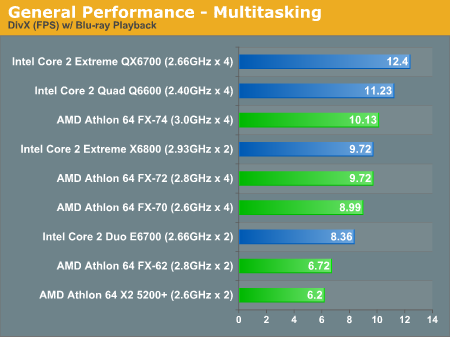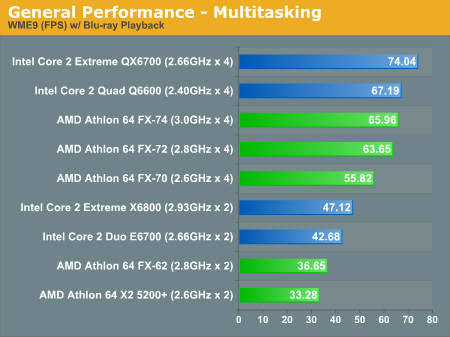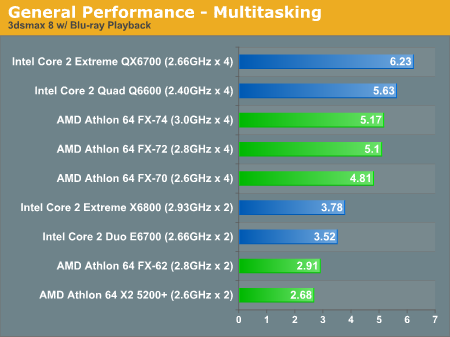AMD's Quad FX: Technically Quad Core
by Anand Lal Shimpi on November 30, 2006 1:16 PM EST- Posted in
- CPUs
Multitasking Performance
When we were trying to think up new multitasking benchmarks to truly stress Kentsfield and Quad FX platforms we kept running into these interesting but fairly out-there scenarios that did a great job of stressing our test beds, but a terrible job and making a case for how you could use quad-core today.
Without a doubt, in the next two years the number of applications that see a benefit when running on four cores will increase dramatically. Even multitasking under Windows Vista will make the argument for more cores easier (simply opening a new Explorer window in Vista will eat up 10% of the CPU time of a Quad FX system), but our Vista benchmarks are not yet complete and we wanted to have something to showcase for this review.
While working on our Quad FX article we also happened to be working on a follow-up to our HDCP Graphics Card Roundup, focusing on H.264 decoding performance in Blu-ray titles. A light bulb went off and we had our benchmark: how many cores do you need to watch a high bit-rate Blu-ray movie and do something else at the same time on your PC?
The movie we used was Xmen III, encoded in H.264, and featuring bitrates in excess of 40Mbps at times. Our benchmark starts at the beginning of Chapter 18 and continues until our background tasks are complete. This particular segment ranges in bitrate from 13Mbps up to above 40Mbps, with the average falling in the 18 - 24Mbps range.
We played the movie in the foreground, while in the background we either ran our Cinebench test, encoded a DivX movie, encoded a WME9 movie or performed our 3dsmax test.
The two rendering tests are important because rendering can take a bit of time and it might be nice to entertain yourself with a movie while your rendering completes; after all, what's the point of having $1000 worth of CPUs if you can't use them for entertainment?
The two encoding tests are also important because being able to encode and decode at the same time is a fundamental requirement for a DVR, and at some point the next-generation of media center PCs will need to be able to decode high bitrate HD movies while encoding others. We chose to include both DivX and WME because DivX runs much better on Intel CPUs, while the standings are a bit closer under WME, to give you a better overall impression of how the two platforms handle these heavy multitasking scenarios.
Our first test involved us playing back the BD title while running our multi-threaded Cinebench test; we reported the Cinebench score upon its completion:

The dual core processors all fall to the bottom of the list and basically perform like single-core CPUs while decoding the Blu-ray movie. The quad-core setups do much better and perform very well, but all of the CPUs in this test were able to run without dropping any frames in the BD movie.
Making things a bit more difficult, our next test had the same movie playing back but this time we ran our DivX encoding test in the background. We reported the DivX encoding frame rate upon completion:

Performance is pretty much what you'd expect, although Intel's superior DivX encoding performance results in the Core 2 Extreme X6800 doing almost as well as the FX-74. What you don't see however is how well these systems played back the Blu-ray movie; none of the dual core setups were able to play the BD movie smoothly, not even the Core 2 Extreme X6800. The movie was basically unwatchable due to all of the pausing and stuttering.
All of the four core systems played the BD movie fairly well; although they all dropped some frames, it wasn't enough to totally ruin the experience.
Next up we tried playing our BD title while running our WME9 test, and found similar results:

Once again, none of the dual core platforms were able to play the BD title even remotely smoothly. The quad-core setups were able to play the movie while encoding, but still managed to drop some frames (not enough to ruin the experience though).
Our final multitasking test has us playing the same BD title while running our 3dsmax 8 render test:

Much to our disappointment, none of the systems could handle this workload without ruining the movie playback; even the quad-core setups had troubles. We're not talking a few dropped frames, but rather the movie playback would be completely stopped at times. It looks like we may have a scenario for either more GPU assisted H.264 decode or an 8-core Quad FX platform in the future.










88 Comments
View All Comments
Neosis - Friday, December 1, 2006 - link
However (in my opinion) since all these four cores share the same 8MB L2 cache and Intel's memory disambiguation forces all cores to use L2 cache more, additional latencies are not significant as the Amd's 4x4 platform. But you are right again that connecting the dies through the FSB requires all die to die communication to go back to the Northbridge and into the system memory. That can be a serios perfomance issue when Amd has competing processers.
mino - Friday, December 1, 2006 - link
Kentsfield == 2 Conroes stuck on 1 FSB. They have _separate_ 4M L2 cache. No 8M L2 on the horizon..Neosis - Thursday, November 30, 2006 - link
Where is edit button?The first sentence should be "I think ..."
Neosis - Thursday, November 30, 2006 - link
I don't think AMD can compete with Kenstfield even with this platform. Enthuiasts usually don't care power consumption and heat problems. A water cooling system (with a large radiator and a strong pump) will do just good. The main concern is neither the power consumption nor the heat problems. When you install two dual core processor, you are going to have performance down due to the increased latency. Nearly in all benchmarks Intel is leading. No suprise that only one motherboard manufacturer was in on.Even though I'm an AMD user, I don't see any particular reason people will buy this. But I can say why not:
- no one knows how long Amd will support this platform. In the past years Amd has beem changing sockets almost each year and half. We know Socket Am3 will use Ddr3.
- pricing
Griswold - Saturday, December 2, 2006 - link
Well the first part isnt quite true or very precise, as for the second part, we also know that AM3 CPUs will run in AM2 sockets (but not vice versa). On top of that, we're talking about Socket F here and not AMx.
If you want to name a good reason to not buy this: The other option is just that much better. End of story. If you want quad AMD, wait 6 months.
Gigahertz19 - Thursday, November 30, 2006 - link
On black Friday I was at Circuit City and some store employee near me was telling this woman who was looking for a computer to make sure she buys a computer with a AMD processor because their faster and all around better. I couldn't stand there and let him lie to that woman so I went over there and told her she needs to buy a comp with a Core 2 Duo and gave my reasons. Then the Circuit City guy went into this rant about AMD and the 5000+ processor and how it's the best, haha apparently he hasn't updated his knowledge for quite sometime. I could of stood there and argued it but I just said okay and walked away, didn't walk to make a scene...plus how geeky would that be arguing over processors in the middle of a store where customers are.Anyways looks like Intel Core 2 Duo tech is the thing to get. I'm stilling running a old XP-M overclocked with a DFI Socket A mobo. I want to upgrade to Core 2 Duo sometime soon probably get the Core 2 E6600 only because it has 4Mb cache and the slower speed ones don't. Overclock that baby to 3GHz which should be a given with the right mobo like the Evga one and I'll have a awesome system, probably buy a X1950 XT or Pro for around $250 then upgrade to DX10 when it gets cheaper.
madnod - Thursday, November 30, 2006 - link
i am really into AMD and i was buying AMD since the last 4 years, but this time intel isreally pushing ahead.there is a major thing that intel is doing these days and it's really funny to see the way AMD is responding to that, it kinda remind me of the 3DFX approach, start stacking more things that u already have and wish that things will be better.
AMD should expedite their transition to the newer CPU desgin, the current K8 architecture can't keep up with the core technology.
THX - Thursday, November 30, 2006 - link
Very nice tests. I can't believe the power draw AMD is dealing with here.Ecmaster76 - Thursday, November 30, 2006 - link
The pin count of AM2 probably isn't an issue. It has as many pins as 940 which can handle multiple HT links and dual channel memory.AMD just moved it tot he other socket to people from buying the bundled CPUs and selling them individually for a profit. The 2.6 GHz model for example runs about $100 less per chip than the standard X2 does.
punjabiplaya - Thursday, November 30, 2006 - link
Are we going to see updated benchmarks with 64 bit performance and/or Vista and when there is a BIOS fix for the NUMA issues on the board (not the WinXP shortfalls as far as NUMA is concerned, Vista should take care of that)?Just curious.